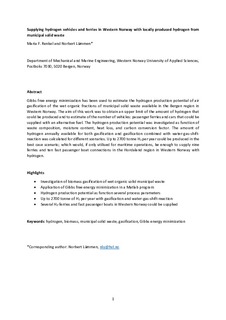Supplying hydrogen vehicles and ferries in Western Norway with locally produced hydrogen from municipal solid waste
Journal article, Peer reviewed
Accepted version

View/
Date
2018Metadata
Show full item recordCollections
- Import fra CRIStin [3604]
- Institutt for maskin- og marinfag [363]
Original version
Renkel, M. F., & Lümmen, N. (2018). Supplying hydrogen vehicles and ferries in Western Norway with locally produced hydrogen from municipal solid waste. International Journal of Hydrogen Energy, 43(5), 2585-2600. 10.1016/j.ijhydene.2017.12.115Abstract
Gibbs free energy minimization has been used to estimate the hydrogen production potential of air gasification of the wet organic fractions of municipal solid waste available in the Bergen region in Western Norway. The aim of this work was to obtain an upper limit of the amount of hydrogen that could be produced and to estimate of the number of vehicles: passenger ferries and cars that could be supplied with an alternative fuel. The hydrogen production potential was investigated as function of waste composition, moisture content, heat loss, and carbon conversion factor. The amount of hydrogen annually available for both gasification and gasification combined with water-gas-shift-reaction was calculated for different scenarios. Up to 2700 tonne H2 per year could be produced in the best case scenario; which would, if only utilised for maritime operations, be enough to supply nine ferries and ten fast passenger boat connections in the Hordaland region in Western Norway with hydrogen.
